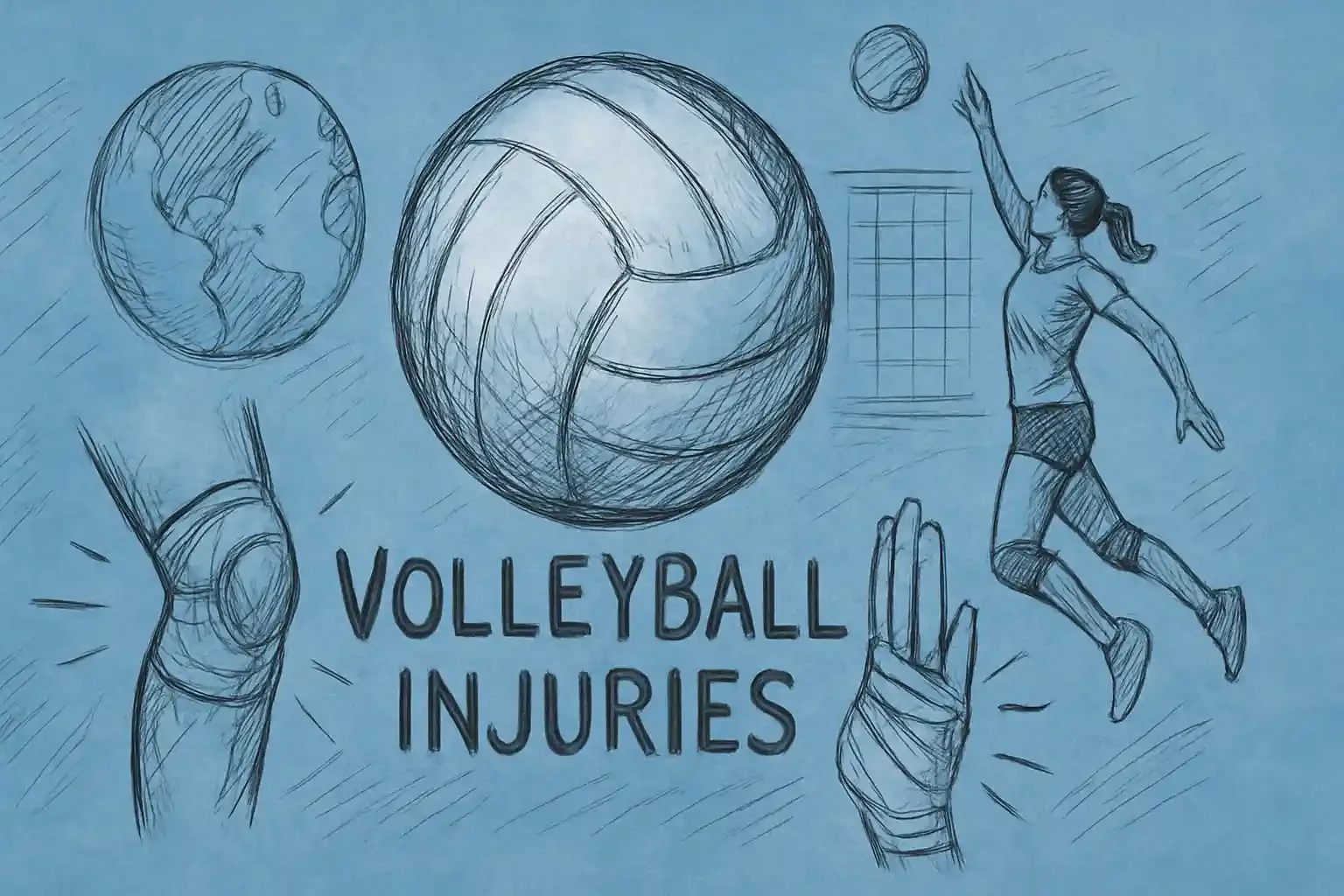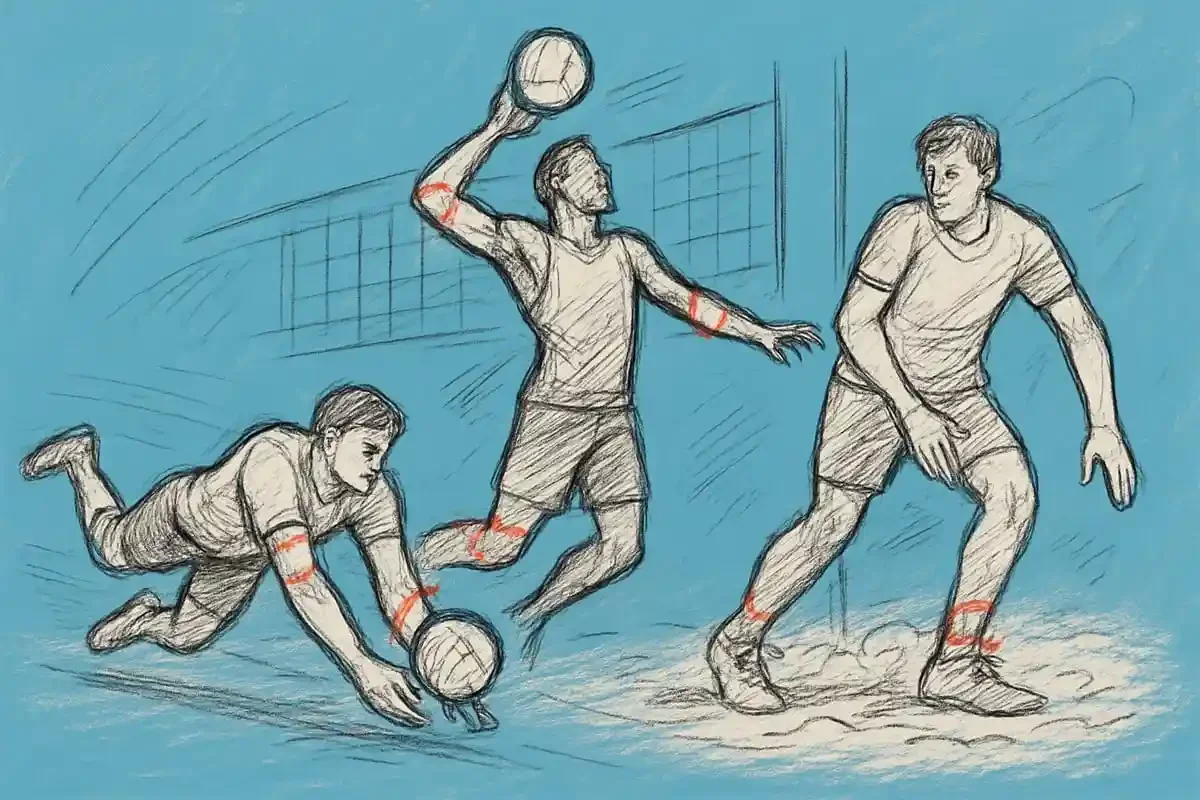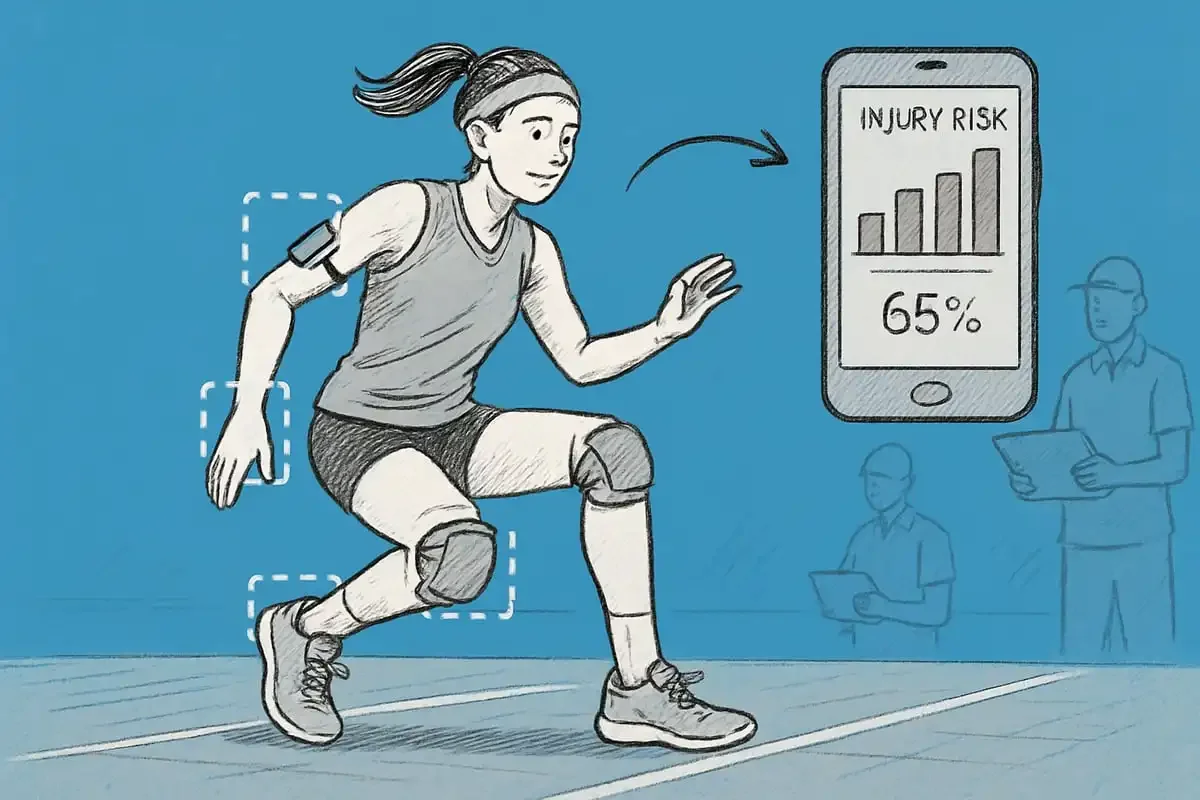8 Most Common Volleyball Injuries and How to Prevent Them 2025
Volleyball captivates over 800 million players worldwide, drawing athletes of all ages to its fast-paced action and intense physical demands. Yet, the sport’s explosive jumps, rapid direction changes, and repetitive movements put participants at risk for volleyball injuries. Whether you’re an athlete, coach, or parent, understanding these risks is crucial.
In this guide, we break down the 8 most common volleyball injuries for 2025, providing real data, practical prevention strategies, and expert insights to keep you or your athlete healthy and active. For those seeking specialized care in North Vancouver, Mountain Health and Performance offers advanced management, rehabilitation, and injury prevention services tailored to volleyball athletes. Stay informed and take action to stay strong on the court.
The Growing Prevalence of Volleyball Injuries: Trends and Risk Factors
Volleyball is surging in popularity worldwide, with over 800 million people participating in some form of the sport. As more athletes play at every level, the conversation around volleyball injuries becomes even more critical. According to recent Volleyball Injury Statistics 2025, injury rates are rising, especially in youth and elite leagues. This increase highlights the need for better awareness and prevention strategies.
Several risk factors contribute to the high rate of volleyball injuries. The repetitive overhead motions required for serving and spiking place significant stress on the shoulders. Frequent jumping and hard landings can overload the knees and ankles. Differences between indoor and beach court surfaces further influence injury risk, as do player specialization and training intensity. Understanding these factors is essential for reducing injury rates.
Gender and age also play a role in the types and frequency of volleyball injuries. Studies show that female athletes are more likely to experience overuse injuries, while male players often face more acute, time-loss injuries. Youth athletes are particularly vulnerable as their bodies are still developing, while professionals experience greater stress due to higher match volumes. The most commonly affected areas are the lower extremities, such as ankles and knees, followed by fingers, shoulders, and, less frequently, the head and spine.
Volleyball injuries can be divided into two main categories: acute and overuse. Acute injuries, like ankle sprains and finger dislocations, often occur suddenly during play. Overuse injuries, such as patellar tendinopathy and rotator cuff issues, develop gradually from repetitive stress. Both types can have long-term implications if not managed properly. Data from NCAA and FIVB studies reveal that ankle and knee injuries remain the most prevalent, while overuse conditions are increasingly common in high-volume athletes.
Proper recovery practices, training adjustments, and specialized care are key to preventing long-term issues from volleyball injuries. Mountain Health and Performance stands out as a trusted partner for volleyball athletes in North Vancouver, offering expert management of volleyball injuries. Their team provides comprehensive services, including injury assessment, rehabilitation, and individualized prevention plans, ensuring athletes can recover fully and return to the court stronger.
8 Most Common Volleyball Injuries and How to Prevent Them
Volleyball injuries are an unfortunate reality for athletes at every level, but understanding the risks is the first step to staying healthy on the court. In 2025, the most common volleyball injuries reflect the sport’s evolving demands and intense pace. Prevention is crucial, and expert clinics like Mountain Health and Performance in North Vancouver are at the forefront of helping athletes recover and return to play safely.
Here’s a quick look at the eight most common volleyball injuries affecting players today:
Injury / Body Region / Typical Cause
Ankle Sprains / Lower Extremity / Landing, jumping, stepping on foot
Patellar Tendinopathy (“Jumper’s Knee”) / Knee / Repetitive jumping, overuse
Finger Sprains and Dislocations / Hand/Fingers / Ball contact, collisions
Shoulder Overuse Injuries / Shoulder / Repetitive overhead motions
Concussions and Head Injuries / Head/Neck / Ball strikes, collisions, falls
Low Back Pain and Muscle Strains / Back / Jumping, trunk rotation
ACL and Knee Ligament Injuries / Knee / Sudden pivots, awkward landings
Stress Fractures (Lower Extremity) / Legs/Feet / Overtraining, repetitive loading
Each injury below covers causes, symptoms, prevention strategies, and data-backed insights, so you can protect yourself or your athletes from the most prevalent volleyball injuries.
1. Ankle Sprains
Ankle sprains are the number one volleyball injuries, accounting for up to 30 percent of cases among elite players. Most occur when landing from a jump, especially if a player lands on another’s foot or the edge of a shoe.
Symptoms of ankle sprains include swelling, pain, instability, and trouble bearing weight. Early movement and gradual loading are essential for recovery, but improper rehab can lead to chronic instability.
Prevention Strategies:
Proprioceptive training (balance exercises)
Ankle braces or taping for support
Strengthening lower leg muscles
Practicing safe landing techniques
Studies from the NCAA and FIVB show targeted prevention programs can cut ankle volleyball injuries significantly. Mountain Health and Performance in North Vancouver offers tailored rehabilitation and return-to-play protocols, ensuring athletes regain stability and confidence.
Failing to address ankle sprains correctly may set the stage for long-term issues, so professional guidance is key.
2. Patellar Tendinopathy (“Jumper’s Knee”)
Jumper’s knee is a frequent overuse injury in volleyball, especially among hitters and blockers who jump repeatedly. It causes pain just below the kneecap, worsening with jumping, squatting, or taking stairs.
Patellar tendinopathy affects up to 12 percent of all volleyball injuries. Symptoms begin subtly but can progress if ignored.
Prevention tips:
Eccentric quadriceps strengthening
Flexibility routines for the lower body
Managing training load and taking rest days
Wearing shock-absorbing shoes
Early intervention is vital. Physical therapy, modifying activity, and a gradual return to sport can keep jumper’s knee from becoming chronic. Mountain Health and Performance in North Vancouver provides expert assessment, individualized rehab, and ongoing support for those struggling with knee pain.
3. Finger Sprains and Dislocations
Quick reflexes are vital in volleyball, but fingers often take the brunt during blocks, digs, or sets. Finger volleyball injuries are among the top three for both youth and elite players.
Symptoms include pain, swelling, and visible deformity. Dislocations require immediate reduction, while sprains need splinting and careful rehab. If neglected, chronic stiffness or instability can develop.
How to prevent finger injuries:
Learn and use correct hand positioning
Tape fingers for extra support
Emphasize technical skill during blocking and setting
Scottish National League data shows fingers account for 22 percent of elite volleyball injuries. Mountain Health and Performance offers hand-specific therapy, splinting, and guides athletes through safe rehabilitation for optimal recovery.
4. Shoulder Overuse Injuries (Rotator Cuff Tendinopathy, Impingement)
Serving, spiking, and repetitive overhead movements put volleyball athletes at high risk for shoulder overuse injuries. These issues often appear as pain, weakness, and trouble reaching overhead, especially at night.
Attackers and servers are most vulnerable, with studies reporting up to 10 percent incidence of shoulder volleyball injuries. Early recognition and rest are crucial to avoid chronic pain or reduced performance.
Prevention includes:
Strengthening rotator cuff and shoulder blade muscles
Monitoring and limiting overhead repetitions
Focusing on proper technique
Volleyball shares similar shoulder risks with baseball and tennis. Mountain Health and Performance in North Vancouver uses advanced assessments and hands-on therapy to address shoulder pain, restore function, and prevent future problems.
5. Concussions and Head Injuries
While less common, concussions and head injuries in volleyball can have serious consequences. These occur when the ball strikes the head, during net collisions, or from falls.
Symptoms range from headaches and dizziness to confusion or memory lapses. Even a single concussion demands immediate removal from play and careful monitoring.
Prevention strategies:
Promote on-court awareness and communication
Teach safe net play techniques
Follow strict return-to-play protocols
NCAA and high school data show volleyball injuries to the head are rare but potentially severe. Education for athletes, coaches, and parents is vital.
6. Low Back Pain and Muscle Strains
The explosive movements of volleyball—jumping, landing, and trunk rotation—often lead to low back pain and muscle strains. These volleyball injuries represent 17 percent of cases in elite players.
Common symptoms include localized pain and muscle tightness. Ignoring these signs can result in chronic back problems.
Prevention measures:
Regular core strengthening
Dynamic warm-up and cool-down routines
Monitoring and adjusting training loads
Rehabilitation involves active recovery, manual therapy, and gradual return to play. For persistent cases, relieve low back pain with massage is an effective strategy supported by Mountain Health and Performance, which specializes in restoring spinal health for volleyball athletes.
7. ACL and Knee Ligament Injuries
ACL injuries, though less frequent, are among the most severe volleyball injuries. They often happen during sudden stops, pivots, or awkward landings.
Symptoms include a popping sound, rapid swelling, and knee instability. Female athletes are at higher risk due to anatomical and hormonal factors.
Prevention tips:
Neuromuscular training programs
Plyometric and landing technique drills
Building lower body strength
Treatment ranges from surgical repair to conservative rehab, with return-to-play timelines varying widely. Mountain Health and Performance guides athletes through each step, reducing re-injury risk and supporting long-term knee health.
8. Stress Fractures (Lower Extremity)
Stress fractures are rising among volleyball athletes, especially youth and those with high training volumes. These volleyball injuries are caused by repetitive loading and insufficient rest, often affecting the tibia or metatarsals.
Symptoms include localized pain and swelling that worsens with activity. Early diagnosis with imaging is crucial.
How to prevent stress fractures:
Gradually increase training intensity
Ensure proper nutrition, especially calcium and vitamin D
Schedule regular rest periods
Management includes activity modification, cross-training, and supervised return to sport. Mountain Health and Performance offers expert evaluation and recovery plans, helping North Vancouver athletes avoid setbacks and return stronger.
Recognizing and preventing volleyball injuries is a team effort. Clinics like Mountain Health and Performance provide specialized care, from acute injury management to long-term rehabilitation, ensuring every athlete can play safely and confidently.
Position-Specific Injury Patterns and Prevention Strategies
Volleyball injuries are not distributed equally across all players. Each position on the court faces unique physical demands, which shapes the type and frequency of injuries experienced. By understanding these patterns, athletes and coaches can tailor prevention strategies and keep players healthy and performing at their best.
Attackers and Blockers: Unique Injury Risks
Attackers and middle blockers are frequently exposed to repetitive overhead motions and high-impact jumping. These positions account for a higher rate of shoulder, knee, and finger volleyball injuries. Attackers, especially outside hitters, often develop shoulder overuse issues due to heavy spiking and serving loads. Middle blockers are at increased risk for finger sprains and dislocations, as they regularly challenge opposing hitters at the net.
Landing awkwardly after blocks or attacks can also lead to ankle sprains or knee ligament injuries. Data from the Epidemiology of Common Injuries in Volleyball study highlights that these players experience a substantial share of lower extremity and upper limb issues.
Setters and Defensive Specialists: Hand and Overuse Patterns
Setters and defensive specialists, such as liberos, face their own set of volleyball injuries. Setters are prone to finger sprains, dislocations, and chronic hand pain due to repetitive ball contact and quick reaction plays. Overuse injuries in the wrist and forearm are also common in this group, as they handle countless sets and digs during practice and games.
Defensive specialists, who spend much of their time diving and digging, experience more low back pain and muscle strains. Fast lateral movements and abrupt changes in direction can also put stress on the ankles and knees. Proper hand positioning, technique coaching, and targeted strength training are essential for minimizing these unique risks.
Gender and Age: Injury Trends in Volleyball
Volleyball injuries also vary by gender and age. Female athletes are more likely to develop overuse injuries, particularly in the knee and shoulder, possibly due to anatomical and hormonal factors. Male players, on the other hand, have a slightly higher incidence of acute, time-loss injuries, such as ankle sprains and finger dislocations.
Youth and adolescent players are susceptible to growth plate injuries and overuse conditions as their bodies develop. Collegiate and elite athletes face increased risk due to higher training loads and match intensity. Recognizing these patterns helps coaches and medical teams implement age-appropriate prevention and recovery protocols.
Prevention Strategies and Role of Mountain Health and Performance
Effective prevention of volleyball injuries requires individualized approaches. Position-specific warm-ups, strength and conditioning routines, and skill training should be tailored to each athlete’s needs and role. Coaches are encouraged to monitor player workload, rotate positions when possible, and emphasize proper technique.
Mountain Health and Performance stands out as a leader in managing volleyball injuries in North Vancouver, offering expert care and community support for athletes at all levels. Their team provides injury assessment, rehabilitation, and prevention programs designed for volleyball players. They also contribute to the volleyball community injury support, sharing knowledge and best practices to keep athletes on the court. By combining medical expertise with sport-specific strategies, they help reduce injury risk and promote long-term performance.
The Latest Advances in Volleyball Injury Prevention for 2025
Staying ahead of volleyball injuries in 2025 means embracing both cutting-edge technology and proven prevention strategies. New tools, such as wearable sensors and smart injury tracking apps, are transforming how athletes and coaches monitor training load at the highest level. These advances help identify risky load conditions before injury strikes, allowing for real-time adjustments and safer play.
Evidence-based warm-up protocols are now a cornerstone of elite volleyball programs. Neuromuscular training routines, like a modified FIFA 11+ program for volleyball, are shown to reduce ankle and knee injuries by improving balance, strength, and coordination. Teams are also adopting biomechanical assessments to tailor these routines to each athlete’s needs, ensuring that volleyball injuries are prevented before they impact performance.
Recovery is no longer an afterthought. Today, sleep quality, nutrition, and structured active rest are actively tracked to support tissue healing and minimize overuse volleyball injuries. Multidisciplinary care is vital, bringing together athletic trainers, physical therapists, and sports medicine experts for comprehensive support. Mountain Health and Performance stands out for its expertise in managing volleyball injuries, offering personalized rehabilitation, injury prevention education, and chiropractic care. Their approach emphasizes early intervention, functional recovery, and return-to-play planning, as highlighted in their sports injury management benefits.
Teams are also investing in injury surveillance and reporting systems. These tools help coaches and athletes spot trends in volleyball injuries, adapt training loads, and rotate player positions to avoid overuse. This holistic, data-driven approach is already leading to fewer missed games and healthier seasons.
Looking ahead, the future of volleyball injuries prevention is bright. Success stories from collegiate and pro teams show that combining technology, expert care, and evidence-based routines dramatically reduces injury rates. For more practical advice on staying healthy throughout the season, check out these Volleyball Injury Prevention & Recovery Tips. By staying informed and proactive, athletes, coaches, and parents can ensure that volleyball remains a safe, dynamic sport well into 2025.
After learning about the most common volleyball injuries and the steps you can take to stay safe on the court, it’s clear that prevention and early care make all the difference. Whether you’re dealing with aches from intense games or want to keep your body in top shape for the season ahead, seeing an experienced chiropractor can be a game changer. At Mountain Health and Performance in North Vancouver, you’ll get personalized care from a team that truly understands sports injuries. If you’re ready to feel and play your best, Book with one of our chiropractors today.



